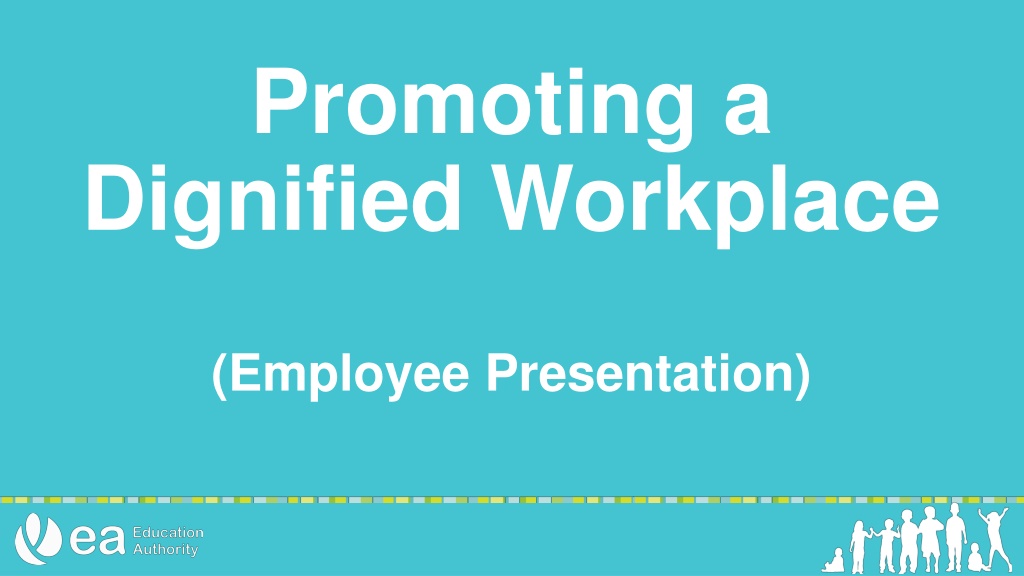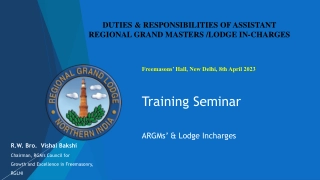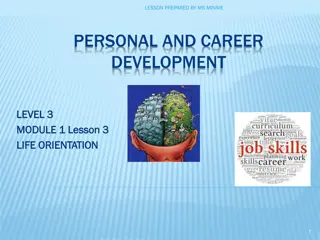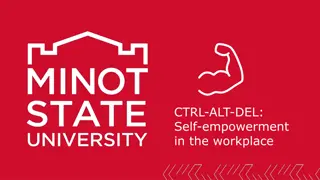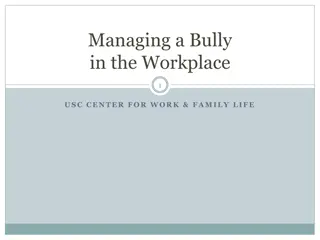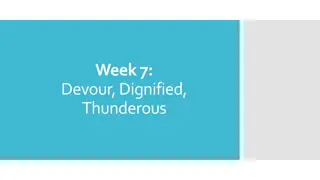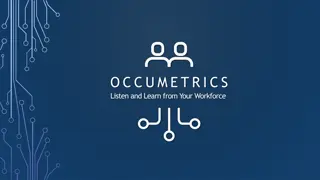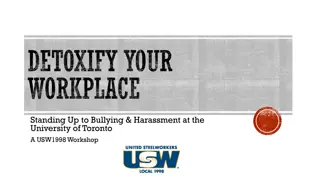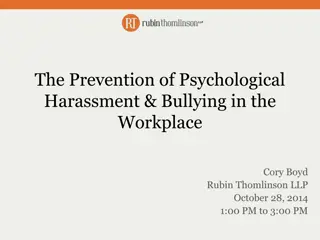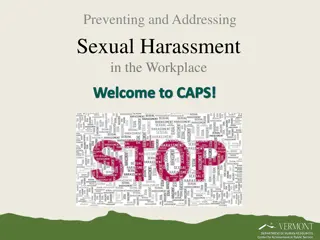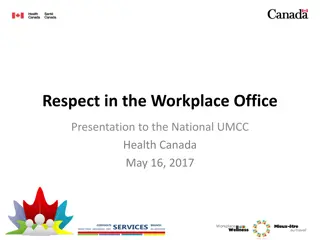Promoting a Dignified Workplace: Policies, Benefits, and Responsibilities
Understand the policies and benefits of promoting dignity at work, along with the roles and responsibilities of employees and managers in creating a harmonious and inclusive workplace. Learn about the importance of addressing unacceptable behavior, distinguishing between bullying and harassment, and maintaining a positive work environment for improved staff wellbeing, retention, and performance.
Download Presentation

Please find below an Image/Link to download the presentation.
The content on the website is provided AS IS for your information and personal use only. It may not be sold, licensed, or shared on other websites without obtaining consent from the author. Download presentation by click this link. If you encounter any issues during the download, it is possible that the publisher has removed the file from their server.
E N D
Presentation Transcript
Promoting a Dignified Workplace (Employee Presentation)
Learning Outcomes Learning Outcomes Understand the relevant policy on Dignity at Work Understand your role and responsibilities Be able to identify unacceptable behaviour Understand the difference between bullying and harassment Have an awareness of approaches to dealing with unacceptable behaviour
Benefits of Dignity at Work Benefits of Dignity at Work Commitment to a harmonious and supportive working environment, and treating dignity at work as a serious issue is likely to have the following benefits: A positive impact on the wellbeing of all staff and reduced absence levels Better staff retention Better industrial relations Higher morale and improved performance More productive workforce Improved service delivery
Promoting a Dignified Workplace EA Values Joint Social Media Policy Declaration of Protection Dignity at Work Policy & Code of Practice Acceptable use of ICT Policy Equal Opportunity Policy Health & Safety Policy
Joint Declaration of Protection June 2018 Everyone has the right to: equality of opportunity in employment work in a harmonious and inclusive environment, regardless of gender, disability status, religion, race, sexual orientation or any other protected characteristic Managers/Principals should work towards creating inclusive cultures and working environments, where staff feel welcome and can apply their diverse talents, ensuring that no member of staff experiences discrimination or harassment
Roles and Responsibilities of the: Roles and Responsibilities of the: Line Manager/Principal Communicate and promote awareness of the policy to employees Ensure that unlawful discrimination, harassment, bullying or victimisation does not occur Set a good example Ensure any complaint is treated seriously, sensitively and in confidence Employee All employees have a responsibility to co-operate in the promotion of harmonious working relationships To comply with relevant policies Ensure that their behaviour to colleagues does not cause offence and could not in any way be considered to be unacceptable
What is unacceptable behaviour?
Harassment or Bullying? Harassment or Bullying? Mrs McLaughlin was employed as an optical assistant. After a period of sick leave, she informed her line manager that she was suffering with depression to which he replied that he had no sympathy for this kind of thing, that everyone gets depressed sometimes, and you just have to pull yourself together .
Harassment Harassment Harassment usually occurs where a person is subjected to unwanted conduct in relation to an equality ground with the purpose or effect of creating an environment which is hostile, degrading, humiliating, offensive or intimidating. Harassment, can occur even if the conduct is not intended to be offensive. I didn t mean to offend anyone not an excuse!
Bullying Bullying Bullyingis defined as persistent, offensive, abusive, intimidating, malicious or insulting behaviour, abuse of power or unfair penal sanctions, which makes the recipient feel upset, threatened, humiliated or vulnerable, which undermines their self-confidence and which may cause them to suffer stress . Bullying behaviour need not be related to an equality ground, but may be for some other reasons. Legitimate and constructive performance management is not bullying
Key Differences Key Differences Harassment Relates to social identity Can be a one off Anti-discrimination laws protect Recognition of harassment is usually straight forward Protection from victimisation Bullying Is social identity (equality ground) neutral Tends to be a series No specific legislation exists to ban bullying Can be difficult to recognise/ identify No equivalent protection
Victimisation Victimisation Distinct form of discrimination Narrow definition - being picked on due to involvement in some capacity Example of legal definition .a person ( A ) discriminates against another person ( B ) if he/she treats B less favourably than he/she treats others in the same circumstances and does so because B has brought proceedings against A or any other person, given evidence/information in connection, alleged A has committed an act contravening the Regulations .
Banter Banter Oxford Dictionary definition is: Humorous ridicule; good-humoured personal remarks Make fun of Talk jestingly Banter, however innocent, has potential for mischief. What is banter for some, may be intimidating or embarrassing to others. What is banter today, may be dangerous tomorrow. There should be no place in the workforce for conduct that has the potential to disrupt the harmonious working environment or to intimidate or embarrass any worker or his/her religious or political opinions. (arising Grimes-v-Unipork Ltd (1992) Fair Employment Tribunal) This applies to all equality grounds
Social Media Social Media Cyber-bullying includes: sending malicious emails, texts, instant messages; Sharing, compromising or harassing images online with others; or displaying screensaver featuring offensive content.
Liability? Liability? A male worker gropes a female co-worker at the Christmas party. His attentions were completely unwanted by her and she was extremely upset. It is an act of sexual harassment however, is the employer labile as the incident occurred at a local hotel?
Effective Resolution Using Procedure Effective Resolution Using Procedure Informal Resolution effective way to deal with a complaint and restore working relations as quickly as possible. Employees have a number of options available: Seek Approach person directly confidential advice, assistance or support Mediation OR OR Formal Resolution can be used when it is either impractical to reach an informal resolution and/or the nature of the alleged unacceptable behaviour requires a more formal approach.
Which of the following statements about Which of the following statements about bullying is correct? bullying is correct? a) Because of their position of authority only managers are in a position to carry out bullying. b) Because of their position of authority managers cannot be the victim of bullying by subordinates. c) Despite their position of authority managers can be the victim of bullying by subordinates. d) A manager's behaviour towards another manager can never amount to bullying.
John makes it clear to his manager, Pete, that he finds the way his colleague Darren refers to the female members of the team as the floozies offensive. Which of the following is correct? a) Pete has investigated the complaint but has been assured by Darren that the term is not meant to be offensive, so he need take no further action. b) As John is a man complaining that he finds a term used to describe his female colleagues offensive, there is no need for Pete to take any further action - the comments don't relate to John's sex. c) As the rest of the team members find the term amusing it is obvious that John is simply being oversensitive, so no further action is necessary. d) Pete should take immediate steps to put a stop to Darren referring to his female colleagues in this way.
Mary has complained to her manager that a colleague, Steve, sexually harassed her at the work Christmas party, which took place one evening in the local pub. Which of the following is correct? a) As the alleged incident happened outside normal working hours, Mary would have no possibility of success if she brought a complaint before a tribunal. b) Since the quiz was for a good cause, even if Steve is guilty of the alleged harassment, any tribunal is likely to view Mary's insistence on complaining about his behaviour in a bad light. c) Mary may be able to bring a successful tribunal claim even if Steve has not sexually harassed her on previous occasions during working hours. d) Although Mary's manager is concerned about her allegations, he can rest assured that, as no one at the company instructed Steve to behave in this way, the company is absolved of responsibility for his actions.
Questions? Questions?
